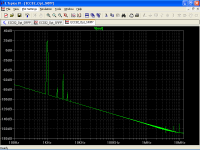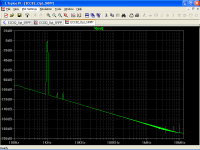The optimized SRPP is very good as preamplifier, input stage in valve power amps and voltage amplifier in hybrid amps. The only potential issue here might be the output volume pot. With no attenuation at the input I would make sure the preamp behaves well also for rather higher output than 1-2 Volts.
Good point, the circuit of post#1 at 10 V RMS output
I know it is a bit expensive but a properly made transformer volume control at the input for me is the best solution. It can also improve quite a bit noise figures while providing easily 20-30K input impedance.
This should be great, unfortunately I just have a 100 K Alps Black Beauty.
Attachments
Still a long way above the spice prediction.
Lowering +B, the ECC82 has different Ra and mu, so you need optimize again the thing.
If it is smoking it is cooking, if it is black it is done.
I am trying to get out the door to teach a class.
Tomorrow I will hook up the 600 Volt variable power supply and run this breadboard at the design 350 B+ volts.
DT
Lowering +B, the ECC82 has different Ra and mu, so you need optimize again the thing.
I am trying to get out the door to teach a class.
Tomorrow I will hook up the 600 Volt variable power supply and run this breadboard at the design 350 B+ volts.
DT
I am trying to get out the door to teach a class.
Tomorrow I will hook up the 600 Volt variable power supply and run this breadboard at the design 350 B+ volts.
DT
LTSpice simulations are greatly dependent on valve models, then maybe you must tweak the output load a little bit until you obtain the "null", but I think that so far results are very good.
The 1 volt output is;
2nd harmonic -76 db
3rd harmonic is -106 db
4th and higher are in the weeds.
Circuit from post#1 with +B=258 V at 1 V RMS output
2nd harmonic -105 dB
3rd harmonic -104 dB
4th and higher are in the weeds.
Then I think that you must adjust a little bit the load to reduce 2nd harmonic, for the 3rd harmonic, LTSpice prediction is a little worse than your measurements.
Attachments
The biggest error between ltspice and real life is the 2nd harmonic. Could that be that ltspice assumes two perfectly similar triodes while in real life they are not?
a SPICE simulated SRPP may cancel perfectly
Popilin,
Even a perfect model, particularly a perfect model has problems of its own. Two perfect 12AU7’s in a SPICE simulated SRPP may cancel perfectly, leading to unreal notching of the distortion. This problem only lives in a perfect SPICE simulation, it will not happen in a real circuit.
I like the test results too.
DT
LTSpice simulations are greatly dependent on valve models, then maybe you must tweak the output load a little bit until you obtain the "null", but I think that so far results are very good.
Popilin,
Even a perfect model, particularly a perfect model has problems of its own. Two perfect 12AU7’s in a SPICE simulated SRPP may cancel perfectly, leading to unreal notching of the distortion. This problem only lives in a perfect SPICE simulation, it will not happen in a real circuit.
I like the test results too.
DT
Last edited:
The biggest error between ltspice and real life is the 2nd harmonic. Could that be that ltspice assumes two perfectly similar triodes while in real life they are not?
SemperFi,
Same thought, You posted it first.
DT
SEPP is a version of SRPP, they only differ in upper and lower tube received separate drive, but they are still a totem pole. The even harmonics are canceled out just like any other PP amp, and in numerous OTL whether Circlotron or Futterman amp. For actual measurement why not read Tim Mellow's OTL amp and his measurement to see why. No offense intended anyway, but correct me if I'am wrong - "even harmonics cancellation are real", as confirmed by many more labs and experiment, include myself. I use PF, positive feedback to restore even harmonics as no amount NFB can restore it!
Last edited:
Why are you restoring the harmonics?
When even harmonics, 2nd, 4th are canceled, the odd harmonics 3rd, 5th become dominance. Without even harmonic, the original balance is lost, although the result is more dynamic, but dried sound. The other reason is I mentioned earlier no amount of NFB can reduce or nullify distortion completely with the absence of even harmonics. That is why in Tim's OTL the harmonics residual remains high at 0.4% mostly odd one, with very high level of NFB already applied as the more NFB, the more even order is reduced but not the odd one. With the restoration of even harmonic you can nullify distortion by means of PF, (reintroduce back even harmonic) to front end such as one of LTP, the distortion is cut down as low as 0.05%, without increasing level of gNFB, therefore maintaining the original harmonics proportion, dynamic as well as not so dry (or wet if you like), making it the best situation of both worlds of dynamic & dry vs dynamic & wet, IMO.
Last edited:
I use PF, positive feedback to restore even harmonics as no amount NFB can restore it!
Why do you restore them? Distortion is distortion. I do not agree with the simplistic thinking that even harmonics are better and the spectrum needs to follow a certain pattern. My main target is to avoid high order harmonics as much as possible and keep THD as low as possible (so it can be 2nd only, 3rd only or a mix). If I have dominant 3rd harmonic but low in magnitude with the 5th harmonic almost in noise floor it will be just fine. If I restore 2nd and 4th harmonics leaving the 3rd unchanged it can only be worse (i.e. more distortion).
Why do you restore them? Distortion is distortion. I do not agree with the simplistic thinking that even harmonics are better and the spectrum needs to follow a certain pattern. My main target is to avoid high order harmonics as much as possible and keep THD as low as possible (so it can be 2nd only, 3rd only or a mix). If I have dominant 3rd harmonic but low in magnitude with the 5th harmonic almost in noise floor it will be just fine. If I restore 2nd and 4th harmonics leaving the 3rd unchanged it can only be worse (i.e. more distortion).
Solid state has more odd harmonic in general I think you're aware of this fact, that is why they constantly look for tube pre-amp. I'm not going to argue with you about the harmonics restoration, is a matter of taste, but not ruled out as you wish!! As to me, dried sound does not mean anything to u? What causes dry sound??
"If I restore 2nd and 4th harmonics leaving the 3rd unchanged it can only be worse (i.e. more distortion)"
That could be true, but not what I tell you, you read again what I said.
Last edited:
Solid state has more odd harmonic in general I think you're aware of this fact, that is why they constantly look for tube pre-amp. I'm not going to argue with you about the harmonics restoration, is a matter of taste, but not ruled out as you wish!!
Well here in this forum you have plenty of examples showing the distortion of properly made SS amps. Have a look at Pass amps, for example.
Solid state amps can have higher order harmonics just like valve amps can have them.
I only argue on the fact that if restoration means increasing THD then I cannot see the point as you want THD to be low in the first place and without high orders. In my experrience if things are done right and THD is low enough high orders are unlikely to be significant.
Well here in this forum you have plenty of examples showing the distortion of properly made SS amps. Have a look at Pass amps, for example.
Solid state amps can have higher order harmonics just like valve amps can have them.
I only argue on the fact that if restoration means increasing THD then I cannot see the point as you want THD to be low in the first place and without high orders. In my experrience if things are done right and THD is low enough high orders are unlikely to be significant.
What is the harmonic property of done right amp in your option? How Pass amps can be well done is largely due to good components (tube is good component for example). How about the speakers??
"..if restoration means increasing THD"
NO, on the opposite, THD is reduced and harmonics proportion are maintained.
Last edited:
I think I have already told you. THD as low as possible and made of 2nd and/or 3rd only.What is the harmonic property of done right amp in your option?
Not all tubes are "good" just like transistors. What do you mean with "how about the speakers"?How Pass amps can be well done is largely due to good components (tube is good component for example). How about the speakers??
I think I have already told you. THD as low as possible and made of 2nd and/or 3rd only.
Not all tubes are "good" just like transistors. What do you mean with "how about the speakers"?
Speakers can generate odd harmonics in addition, although the amp has less. But the amp is the master, the speaker may produce even more. So odd harmonics are not really insignificant as you put it.
Speakers can generate odd harmonics in addition, although the amp has less. But the amp is the master, the speaker may produce even more. So odd harmonics are not really insignificant as you put it.
It has been demonstrated recently that speakers distiortion is not the same thing. If you have 10% THD in your signal sent to a distiortion-less speaker is not like a distiortion-less amplifier that drives a speaker with 10% distortion. The latter is not perceived. They are not equivalent. If I remember well Geddes did this experiment with compression drivers and published it in the AES Journal.
It has been demonstrated recently that speakers distiortion is not the same thing. If you have 10% THD in your signal sent to a distiortion-less speaker is not like a distiortion-less amplifier that drives a speaker with 10% distortion. The latter is not perceived. They are not equivalent. If I remember well Geddes did this experiment with compression drivers and published it in the AES Journal.
Ok, I think have read that or similar article.
If everything is unchanged, you measured 0.01% of 5th harmonics from your speaker using a microphone and spectrum analyser, but as you or someone moved about, the measured distortion goes up and down depends on the movement. Likewise speaker placement in a room will give a steady odd harmonics distortion too depend on the object in the room. It is perceived with movement and hearing together. But the amp and speaker generates them together, they have to be a master and slave or else it couldn't come out or disappear from nowhere. Never mind.
- Status
- Not open for further replies.
- Home
- Amplifiers
- Tubes / Valves
- Yet another ECC82/12AU7 Line Preamp

